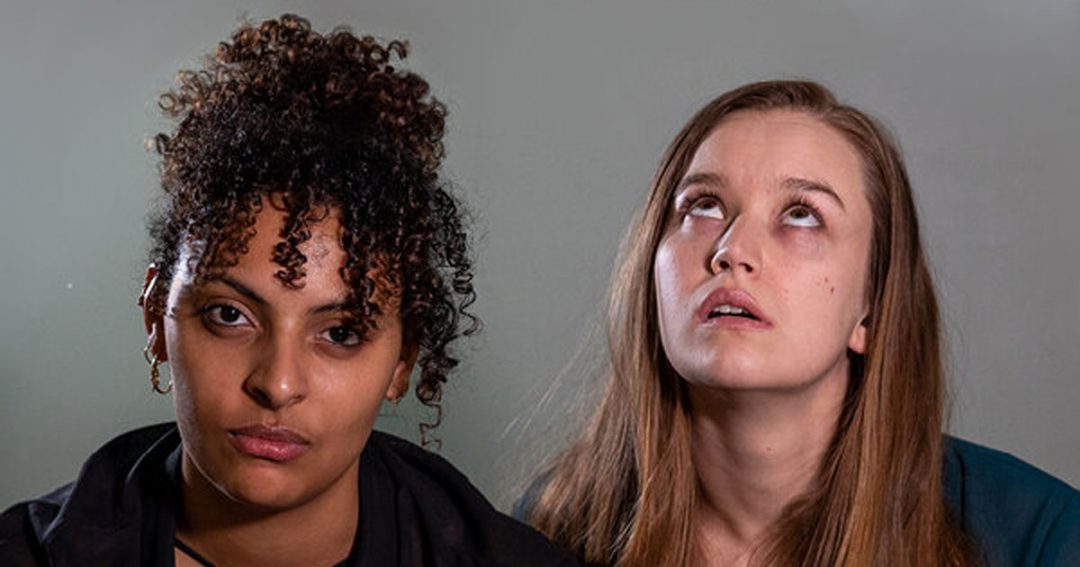“For anything so overdone is from the purpose of playing, whose end, both at the first and now, was and is to hold, as ’twere, the mirror up to nature,” thus wrote Shakespeare in Hamlet. And, thus, Good Company Theatre has obeyed that counsel in its production of Hamlet in the other room at Rumpus.
To give this show perspective and context, we need to start with the original Hamlet.
Approximately 420 years ago, Shakespeare wrote Hamlet, in which a young prince mourns the murder of his father by his uncle, such that the latter might marry Hamlet’s mother and assume the crown. Hamlet then spends most of the play tormented by his inability to take action to revenge the wrongful slaying of his father and, in the midst of this turmoil, causes angst and disruption and mistrust among many, especially for Ophelia who is told she is loved by him and who is then spurned and mocked by this bewildering prince.
Fast forward to 2021, and this young company of female players has deemed the time is right to turn the tables on the Bard and his characters.
Indeed, while Hamlet is one of the most vulnerable and introspective male characters in the great, Western canon, he carries with him all the in-baked patriarchal assumptions and beliefs and values of Shakespeare’s day. It is Hamlet who proclaims, “frailty, thy name is woman,” and it is he who demands that Ophelia gets herself to a nunnery so that she can save herself from being a “breeder of sinners”.
These implicit renderings of females as “breeders” and props, is what has motivated Good Company Theatre to experiment with a group-devised piece in which a company of female players can react against such blinkered and time-locked views. At once the players “play” Hamlet on stage while in the dressing room , they reflect on the misogyny and patriarchy inherent in the storylines of the piece. Behind the scenes, the actors unfold their own personal relationships with each other and contemplate their own readiness to strike out on the “public” stage and thrust a dagger into some of the most insidiously patriarchal elements of this play.
In this way, Good Company Theatre is holding up a mirror to nature because in today’s theatre world there is no refuge for old ideas; or at least there is little appetite for old ideas going unchallenged. In every respect, to hold up a “mirror” within the current state of “nature”, it is right and proper for this company to explore a deconstruction of this master work, and evaluate it under a contemporary microscope.
As you might have sensed, this play is “played” on two stages; the main stage and the dressing room. Audience members are free to wander back and forth between the two “shows”, knowing that in doing so they will miss some elements and see others, such that no two audience members are likely to have the same experience.
On stage, an expansively-staged performance of Hamlet takes place on a sparse set, while in the dressing room the “actors” interact with each other while they are “off”. It is in the dressing room in which we get a glimpse into their inner worlds, their Hamletesque self-questioning, as they discuss their varying degrees of bravado (in relation to deconstructing this show) and they play out their intrapersonal relationships with each other fuelled by minutiae, slow-burning disagreements and camaraderie.
Individual actors and characters have not been singled out yet, in this review, because this is truly an ensemble piece. It is incredibly rare to witness such depth and discipline at any level of theatre in South Australia. Here, director, Zola Allen, has shaped and nurtured the group creative process into a coherent whole. Every scene on both stages is thoughtfully plotted and performed, and the focus of players when not involved in speaking parts is exemplary. Disbelief is well and truly suspended, except when it is deliberately rent by the players who occasionally break the fourth wall to great effect.
To single out some players, or not to single out some players, that is the dilemma. Given the individualised experience of this play for each audience member, for this reviewer, there are a few players whose performances have been indelibly burned into his memory. Kidaan Zellecke (Cassidy / Hamlet) exuded power and presence on the main stage, rolling gracefully with the various sabotages put forward by the other characters. Meanwhile, Katherine Sortini (Vanita / Horatio) was poised and intriguing, especially while in the dressing room. Mikayla Rudd (Thallia / Guilderstern / Bernado) and Poppy Mee (B / Rosencrantz / Marcellus) both had whirling durvish levels of whispish, Shakespearean energy as they brought their roles to life. And Evie Leonard (Sue / Ophelia), gradually transformed and grew in presence throughout the play, ultimately revealing how she had been perfectly cast as the conductor, the lightning rod, who draws the energy of feminine rage, hurt, and proclamation into one central place and then, as it were, sets the feminine cannon against female belittling as she blasts the heavens of literature.
If you have not yet seen this production, those last words will seem rather bewildering, and that is because this play changes form throughout the night, from informal dialogue to Shakespearean “playing” to collective, female chanting and ceremony. Indeed, the choreography and voice work during the climax of the show is breathtaking. Time slows, the actors find a harmonious connection, and the summoning of feminine presence and power enchants us all.
Hamlet In The Other Room is a madcap reworking of Shakespeare, blended with modern reflection, and finished off with powerful, form-fluid celebration of theatre itself. These players shift our focus from Hamlet to Ophelia, mourning and reclaiming her relentless cycle of despair and futility that has played itself out with each performance of Hamlet throughout history. Indeed, Good Company Theatre chides Shakespeare for imbuing this play with the subtext, “futility, thy name is woman”, and they use their anger over this to fuel a creative and memorable exploration.
As an aside, hats off to stage manager, Grace Calabretto, who ensured that players got to where they needed to be with props as required (one suspects stage production to have been more challenging in this play compared to most). And bravo to lighting designer, Hannah Aylett, who created stark contrast between the dressing room and the richly and deeply lit main stage; it facilitated our transition as audience members from the real and internal world to the outward, theatrical world of the stage.
Like with most Shakespeare in this modern age, the dense nature of the script and the differing acoustics within the Rumpus spaces means that you need to be light as you go; you are unlikely to catch or even understand every word that is spoken trippingly on the tongues of these actors. But there are many jewels in this crown and like other works from the theatrical canon, there are discoveries awaiting audiences with each performance.
Hamlet in the Other Room, Good Theatre Company, November 30 December 12, 2021, RUMPUS.

